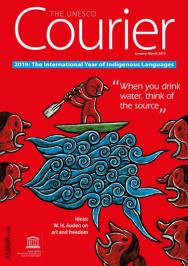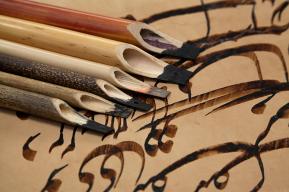مقال
شعب سامي جوكموك يتحدّى الحداثة

في منطقة لابلاند السويدية، يربي شعب سامي غزال الرنّة. لكن المنطقة أصبحت مُهدّدة بسبب استغلال الغابات، والخطوط الحديدية، والسدود والنمو الحضري. وكوسيلة للصمود أمام هذا التهديد، يضع السامي استراتيجيات مُتنوعة، منها التأقلم الجزئي مع نمط الحياة الحضرية واستعمال مهاراتهم التقليدية للتعرف بدقّة على أوضاع المراعي.
بقلم ماري رواي
يحتل شعب سامي، أو اللابيون كما كانوا يُسمّون سابقا، المناطق الواقعة في الدائرة القطبية الشمالية في أوروبا منذ آلاف السنين. ويُقدّر عددهم اليوم بحوالي 80.000 نسمة، ويقطن أغلبهم بأقصى الشمال، في منطقة سابمي (لابلاند) التي تتوزع على أربع دول – فنلندا، والنرويج، وروسيا والسويد – في حين استقر جزء منهم في الناحية الجنوبية، لا سيما في أوسلو وستوكهولم.
وقد أنشأ السامي مجلسا خاصا بهم يسمح لهم بالتفكير المشترك في مستقبل بلدهم، دون اعتبار للحدود الوطنية، علما وأنه في واقع الأمر، لم تمنعهم تلك الحدود أبدا من الشعور بالإنتماء لشعب واحد. وكانت لهم دائما تلك القدرة الفائقة على التأقلم مع الحداثة، مع الإحتفاظ بتجذّرهم في تقاليدهم. حتى أن أول رئيس لهيئة الأمم المتحدة الدائمة المعنية بالشعوب الأصلية كان منهم، كما أنهم يتعاونون بشكل حثيث مع مجلس القطب الشمالي.
وعلى مستوى التمثيل السياسي، تأسس البرلمان السامي بفنلندا منذ 1973، تلاه آخر بالنرويج سنة 1989، وثالث بالسويد في 1993.
يُمارس السامي عدّة مهن. بعضهم فنانون أو مُثقّفون مشهورون، رسامون، ونحاتون، وصحافيون، وكُتّاب، وسينمائيون، ومُطربون، أمثال نيلس-أسلاك فالكيبا أو ماري بوان. لكن المهنة التقليدية لشعب سامي تبقى بامتياز تربية الرنّة.
قدرة فائقة على التأقلم
لنأخذ مثال منطقة جوكموك الواقعة في السويد بجهة نوربوتن (التي تمسح 100.000 كلم2 ، أي حوالي ربع البلاد). تمتاز تلك المنطقة بتربية الرنّة و تعد ما لا يقلّ عن 4000 مُربّ للرنّات ينتمون لشعب سامي. رغم المخاطرالعديدة التي تهدد أرضهم، فإنهم يحتفظون بقدرة فائقة على الصمود. ولا غرابة في ذلك! لقد برهنوا في الماضي على قدرتهم على التأقلم. فبعد أن كانوا يتعاطون الصيد البحري والأشغال الغابية وصيد الرنّات الوحشية، ابتدعوا تربية الرنّة عند قدوم المُعمّرين الإسكندينافيين الأوائل، منذ أربعة أو خمسة قرون خلت، والذي تسبّب في التضاؤل الفادح في عدد الحيوانات الوحشية.
في بداية القرن العشرين، عندما أراد الإنجليز والإسكندينافيون استغلال أنهارهم، بإنشاء سدود لتوليد الكهرباء، وعندما قاموا بحفر جبالهم لاستخراج معدن الحديد لصنع الفولاذ، تمكن السامي من تجاوز تلك الاضطرابات.
في الستينات، لما أصبح استغلال الغابات في السويد وفي فنلندا نشاطا صناعيّا، على حساب التنوع البيولوجي، بقي مُربّو الرنّات على صمودهم المعتاد. بعد ذلك، في السبعينات، أنشأ السامي في ألتا، بالنرويج، واحدا من أول التحالفات البيئية، يضمّ مُدافعين عن حقوق الإنسان وعن السكان الأصليين، للتصدّي لمشروع بناء سد كان يهدد بالقضاء على قرية شتويّة هامّة.
وما انفكّ التوسع الاستعماري يُهدّد بشكل مُتزايد حقوقهم في الصيد البحري والبرّي وحقوقهم على أراضيهم. ومع ذلك فإن مُربي الرنات ما زالوا قائمي الذات.
تهديدات شديدة الخطر
يأخذ سامي جوكموك رنّاتهم إلى الجبال طيلة فصل الصيف، وينزلون بها في الخريف إلى الغابات في السهول. واليوم، أصبحت هذه الغابات تُستغل صناعيا، ويتقاسم المُربّون حقوق الانتفاع مع مالكي الغابات. ويُمثّل هذا التعايش تحدّيا هامّا، ذلك أن مُستغلّي الغابات يقومون بقطع الأشجار بكاملها ثم يزرعون غيرها، بالإضافة لما تتسبب فيه الآلات الضخمة المستعملة من تدهور للأراضي وإتلاف لنبتة الحزاز التي تحصل عليها الرنّات عند حفر الثلج، لِتتغذى منها. علما وأن الحزاز يتطلب فترة تتراوح بين ثلاثين وخمسين سنة حتى ينبت من جديد!
ولا يتوقف الأمر عند هذا الحد. فالأراضي المخصصة لتربية الرنات أضحت اليوم مُجزّأة، تعبرها سكة حديدية لنقل معدن الحديد والمسافرين. كما أن السدود والبحيرات الاصطناعية التي شيدت أصبحت تُعرقل الطرقات التي يستعملها المربون الرحّل، في حين تقلّصت مساحات المراعي جراء اتساع المدن وحفر المناجم .
وها أن شعب سامي يُواجه اليوم صعوبة جديدة، تتمثل في التغيّر المناخي. في الشمال، المشكلة لا تكمن في ارتفاع درجة الحرارة، بل في تداعياتها على عدم استقرار الحرارة في الشتاء. فعندما تتعاقب التقلبات بين الحرارة والبرد باستمرار، تتكون طبقة من الجليد فوق سطح الثلج، مما يجعل الرنّات غير قادرة على الحفر كي تتغذّى.
استراتيجيات تؤلف بين الحداثة والعراقة
لما تُصبح الرنّات غير قادرة على الحصول على غذائها لحالها، يضطر المُربّون لشراء التبن أو مواد غذائية جاهزة (وهي باهظة الثمن وقد لا تتحمّلها الحيوانات)، أو أكياس من الحزاز، وذلك هو الأفضل. ويقوم المربون أحيانا بجمع الحزاز بأنفسهم من الأماكن التي لا تقدر الرنّات على الوصول إليها، كتلك المحاذية للمطار مثلا. هذا جزء من الاستراتيجيات الجديدة التي تبنّاها السامي لضمان بقائهم.
من جهة أخرى، لتحسين مداخيلهم، يُحاولون بيع لحم الرنّات مباشرة من المربي إلى المستهلك، أو اللجوء إلى العمل الموسمي في مجال السياحة. وكثيرا ما تتّجه النساء إلى الشغل القار في مجال التعليم، أو الطب، أو الصحافة، أو الخياطة أو التجارة لضمان اتزان الدخل العائلي الذي أصبح هشّا جرّاء انخفاض عائدات تربية الرنّات.
لكن سلاح السامي الأفضل يكمن في معارفهم التقليدية. ذلك أن معرفتهم بالثلج وتغيّر حالته حسب درجة الحرارة، وما تحتوي عليه لغتهم من مفردات دقيقة ومفصلة لوصف حالاته على تنوعها، كل ذلك يسمح لهم بالمراقبة الدائمة لأوضاع المراعي.
وخلافا للعلوم الغربية التي تحدد، حسب منهجية ثابتة، قدرة الحمولة (أي عدد الحيوانات التي يمكن لقطعة أرض معينة استيعابها) بالإستناد إلى تحليل كمي للنبات، فإن علم شعب سامي يعتمد على ما تكنه الطبيعة.
وبالفعل، حتى يقيّموا وضع المرعى، يقومون يحفر طبقات الثلج وتحليل ما تحتويه من بلّوريات لتقدير آثار الأحداث التي تتالت أثناء الفصل: تطوّر الرياح ودرجات الحرارة، والغابة، والنباتات، وعلاقتها المتبادلة مع الرنّات. ومن ثمّ، يتسنى لهم معرفة وضع المرعى بكل دقة في زمن ومكان محددين، وليس معرفة مدى ثراء المرعى بصفة مطلقة، وهو ما يُمكّنهم من التصرّف بالطريقة الملائمة.
وبِوصفهم مُختصين في التغيّرات المناخيّة، يستند السامي على معارفهم وتجاربهم، حتى يتمكنوا من الصمود، بالرغم من أن قدرتهم على التحرك محدودة بسبب ما يتّسم به التغيّر الشامل من عنف.
By Marie Roué
The Sámi, previously known as the Lapps, have lived in Europe’s Arctic Circle for thousands of years. It is estimated that there are now nearly 80,000 of them, the majority of whom live in the far north, in Sápmi (Lapland), which spans four countries – Finland, Norway, Russia and Sweden. Some have settled further south, notably in Oslo and Stockholm.
The indigenous people have set up a Sámi Council, which allows them to think about the future of their nation together, beyond the national borders that have never prevented them from feeling that they are one people. They have always had the remarkable ability to embody modernity while remaining rooted in tradition. They gave the United Nations Permanent Forum on Indigenous Issues (UNPFII) its first president and are actively involved in the Arctic Council.
Regarding their political representation, the Sámi Parliament of Finland was created in 1973, followed by the Sámi Parliament of Norway in 1989 and the Sámi Parliament of Sweden, in 1993.
The Sámi practise many trades. Some of them are well-known artists or intellectuals, painters, sculptors, journalists, writers, filmmakers or singers – such as the Finnish writer, musician and artist Nils-Aslak Valkeapää (1943-2001) or the Norwegian musician Mari Boine. However, the traditional Sámi profession par excellence remains that of reindeer herding.
A tremendous capacity to adapt
Let’s take the example of Jokkmokk. This major centre for reindeer husbandry in Sweden, in Norrbotten (which covers 100,000 square kilometres, or a quarter of the country), is home to some 4,000 Sámi reindeer herders. They face many threats to their territory but at the same time, have an extraordinary capacity for resilience. Did they not adapt the first time, by inventing reindeer husbandry – even though they were fishermen, trappers and wild reindeer hunters – when the arrival of the first Scandinavian settlers four or five centuries ago caused a drastic decrease in the population of wild animals?
The Sámi also managed to overcome the devastation caused at the beginning of the twentieth century, when the English and the Scandinavians exploited their rivers – by creating dams to generate electricity – and dug their mountains to extract iron ore and produce steel.
The reindeer herders resisted again in the 1960s, when forestry became an industrial activity in Sweden and Finland at the expense of forest biodiversity. Later, in the 1970s, the Sámi created one of the first environmental alliances in Alta, Norway – bringing together human rights defenders and indigenous peoples to oppose the dam that would have led to the demolition of an important winter village.
The advance of colonization increasingly threatened their fishing and hunting rights and their rights to the land. Yet the reindeer herders are still there.
Facing serious threats
The Sámi of Jokkmokk take their reindeer to spend the summer in the mountains, descending to the forests in the plains in autumn. These forests are now being exploited industrially and the pastoralists are forced to share their usufruct rights with forest landowners. This coexistence poses a considerable challenge because the timber growers practise clear-cutting the forests before reseeding them, and their heavy machinery degrades the soil and destroys the lichen that reindeer feed on, by digging snow. It takes thirty to fifty years for the lichen to grow back!
And that's not all. The breeding territory for the reindeer is now traversed and divided by a railway line that transports iron ore and passengers. Dams and artificial lakes obstruct the herders’ migration routes, while roads, cities and mines further reduce the grazing pastures.
Today, the Sámi must overcome a new challenge: climate change. In the north, it is not so much the global warming that is feared, as its consequences on the instability of winter temperatures. When the snow is covered with a layer of ice after successive heating and cooling, the reindeer can no longer dig for food.
Modern and ancient survival strategies
When reindeer can no longer feed themselves, the herders are forced to buy hay or dry food pellets (which are expensive and not always tolerated by the animals), or better still, bags of lichen. Sometimes they gather lichen in areas where the reindeer cannot go, such as around an airport, for example. These are part of the new survival strategies adopted by the Sámi.
In addition, to supplement their income, they now try to sell reindeer meat directly or resort to temporary work in tourism. Women often turn to permanent employment as teachers, doctors, journalists, dressmakers or shopkeepers to balance the family budget – which has been weakened by the fall in their reindeer-herding income.
But the Sámi’s best weapon is their traditional knowledge. With a precise and detailed vocabulary, their knowledge of snow and metamorphism allows them to constantly monitor the condition of the pastures.
Unlike Western science, which has a static vision of load capacity (the number of animals that a given territory can support) based on a quantified botanical analysis, Sámi science is the science of immanence.
To assess the condition of a pasture, they dig and examine the layers and crystallography of the snow, thus estimating successive events through the seasons – the evolution of wind, temperatures, forest, ground vegetation – and their interrelationships with reindeer. Therefore, they may not know the richness of the pasture in absolute terms, but are experts at gauging its condition at the time and place of their analysis, which allows them to act in the most appropriate way.
As climate change specialists, the Sámi base their resilience on their knowledge and practices, even if their capacity for action is limited by the severity of global change.







